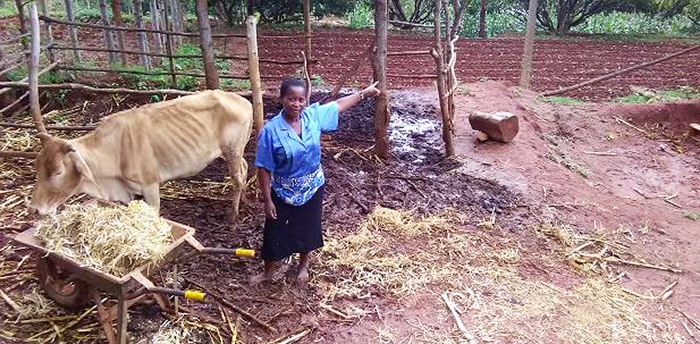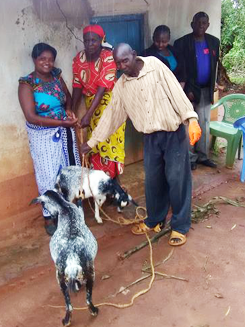ABM Archive Website
THIS WEBSITE CONTAINS ARCHIVE MATERIALS FOR HISTORICAL REFERENCE ONLY
For up-to-date information, including our latest appeals, news, and resources, please visit our current website.
Kenya: Integrated Food Security Program

ABM’s INTEGRATED FOOD SECURITY PROGRAM (IFSP), IMPLEMENTED BY ANGLICAN DEVELOPMENT SERVICES EASTERN (July 2014 to December 2017)
A report written by Dr Terry Russell, June 2018
ABM’s 2014-2017 Integrated Food Security Program (IFSP) was implemented by Anglican Development Services Eastern (ADSE) in Kalawani and Kyawango Locations in eastern Kenya. It was funded by ABM in cooperation with the Australian Aid Program. The objectives of the program varied slightly from year to year but consistently addressed five key themes: to increase water accessibility and portability; to increase agricultural productivity; to strengthen the capacity of Community-based organisations (CBOs) CBOs and Village Savings and Loans (VSL) groups, and to mainstream gender.
This 2018 evaluation aimed primarily to assess the effectiveness of the program. The evaluation utilised mainly qualitative methodologies – such as interviews, focus group discussions, and direct observation – to gather data from a variety of stakeholders. It also examined quantitative data already collected through ADSE’s program reports.
The evaluation found that the program had successfully met all of its objectives, had done so
efficiently, and had introduced a range of mechanisms to make the impacts long-lasting.
The evaluation found the following evidence that the program had positively impacted incomes, food
security, community mobilisation, health, and the environment.
Qualitative evidence:
-

Farmers spoke of incomes and food security being boosted through improved water supply for irrigation, through new agricultural and post-harvest technologies, and through improved access to credit. As evidence, they pointed to an increase in assets like livestock, motorcycles, and household furniture.
- New facilities were clearly being used. The evaluator observed school children using newly installed handwashing facilities in two schools, farmers cooking with newly constructed jikos (fuel efficient stoves), and others using farm ponds and drip irrigation technology to irrigate their fields.
- The ADSE program built two community-based organisations (CBOs), which community members praised as providing a range of community services, like storing and selling farm produce, organising awareness-raising activities and accessing government support. Both CBOs had grown so strong that they had been able to partner with several other international and local organisations to implement extra activities.
- The ADSE program also built Village Savings and Loans groups (VSLs), providing villagers with easy access to credit. Beneficiaries mentioned how loans from the VSLs had allowed them to start new businesses such as tree nurseries and motorcycle taxis.
- A strength of the program was the range of positive impacts reported by women, including financial independence and a more harmonious home life. One woman said she had previously pressured her husband to go to Nairobi to look for work but as new income generation opportunities arose through farming, she no longer pressured her husband and the family was happier.
- Many vulnerable households were sharing in the benefits of the program, although those vulnerable households that remained outside the VSLs had enjoyed fewer benefits since the goat distribution component finished in 2013.
- A few beneficiaries spoke of health aspects such as nutrition and sanitation being improved. Children were able to explain how sanitation-related diseases could spread and how risks could be minimised.
Most of ADSE’s quantitative evidence was related to facilities installed and activities completed rather than to impacts on peoples’ lives. Key quantitative data were as follows:
- 15 sand dams and 12 farm ponds were constructed in July 2014-Dec 2017, providing nearby farmers with a reliable year-round supply of water. Many more sand dams and ponds were constructed by individuals and other organisations replicating the models built by ADSE.

- 16 primary schools were provided with water tanks, eight (8) were provided with hand-washing facilities and four (4) were provided with toilet blocks. These initiatives were combined with awareness raising about hygiene and sanitation.
- 45,303 tree seedlings were planted in school yards and communities, and 404 energy saving stoves (jikos) were constructed by farmers trained through the ADSE program. These initiatives were combined with awareness raising about the benefits of environmental conservation.
- 23 crop demonstration plots and two new nurseries (in addition to nurseries established prior to July 2014) were set up by farmer groups. In addition, in the July 2014-June 2016 period, an average of 550 farmers per year were provided with drought resistant seeds.
- 41 VSLs and three (3) broader organisations (two CBOs and a credit cooperative) were built and strengthened, including assistance with linking to local and international organisations.
- 93 disabled persons were assisted to register with the NCPWD (National Council of People with Disabilities) and given identity cards, enabling them to benefit from free government services such as medical services, tax relief and education support for school children.
The quantitative evidence for impacts on people’s lives was mainly related to individual families or community groups. Quantitative evidence for the overall scale of impacts on people’s lives across the two districts was not as strong. ADSE is steadily moving to correct this. For example, an ADSE survey in Dec 2017 noted that yields per acre of some crops doubled when compared to data from the 2014 mid-term evaluation.
The program made efficient use of resources.
|
|
|
|
||||
|
|
|
|
||||
|
|
|
|
||||
|
|
|
|
ADSE’s staffing costs and administration costs as a percentage of overall costs were very reasonable, although the percentages spent on these in FY 2016/17 were higher than in the previous two years.
Efficiency was boosted through excellent strategies to promote replication, with beneficiaries assisted
to expand their activities and with neighbours looking on and learning indirectly.
Overall, the program had provided new knowledge and income opportunities for an average 12,546 direct beneficiaries per year (and many thousands more indirectly) at an average cost of KSh 15,304,080 per
year.[1]
Many program impacts seemed to be sustainable. The evaluator visited VSLs and many small businesses like poultry farming, vegetable farming and a tree nursery that had gone from strength to strength. Drip
irrigation and other farming technologies introduced in Kalawani continued to be used even after ADSE had begun exiting from the district. An earth dam built by ADSE before 2014 was still being used in
2018, and local farmers had even funded and built washing facilities next to the dam. To aid sustainability of impacts, various local organisations had been built (notably the VSLs and CBOs), providing ongoing
financial services and linkage to government services. Two other local institutions, Mpanzi Credit Cooperative and ADSE itself, require ongoing attention to build their financial self-sufficiency.
Whilst ADSE’s 2014-Dec 2017 Integrated Food Security Program was therefore judged to be an A-grade program, with excellent program management and strong local support, the evaluation found several areas where there may be scope for improvement.
In particular, the evaluation made three generalised recommendations, each followed by discussion points for how the general recommendations might be pursued.
|
|
||||
|
|
||||
|
|
The evaluator wishes to express great appreciation of ADSE’s work from 2014-2017 and of ADSE’s hosting of the evaluator in 2018. May ADSE’s great work in eastern Kenya continue from strength to strength.
Download a .PDF copy of the Integrated Food Security Program 2014-2017 Report here
> Find out more about ABM’s Kenya projects here

[1] At 15 May 2018 exchange rates, this equated to an average cost of AUD $ 203,085 per year.
[2] By ‘seed money’, Joseph meant both donations and money invested in the SACCO. The seed money would be invested in loans to members and repay these loans with interest.
[3] Joseph explained that investment would need to go through a special purpose vehicle because Mpanzi SACCO is registered as Savings and Credit Co-operative Society. Kenyan law has restrictions on investments of the society fund.





